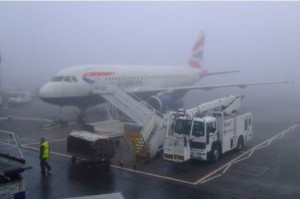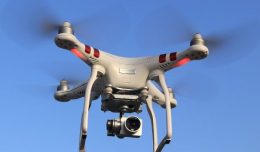After discussing thunderstorms, microbursts and tornadoes, fog seems like a rather benign weather phenomenon. However, countless flight delays, diversions, and cancellations can be attributed to this “surface-cloud,” not to mention numerous auto/boating accidents. But what is fog? And why does it occur regularly at some airports and not others?
Simply put, fog is just water droplets or ice crystals suspended in the air. What differentiates it from being a cloud is simply its altitude (or lack there of) above the surface. Fog also has a more technical definition when being described for aviation purposes, which we will explore that after we take a look at how it forms.
When the air temperature cools to near the dew point temperature (generally 4° or less between them or near 100% humidity) moisture in the air can condense out and form fog. One common situation where we see fog form is when the sun goes down and temperatures begin to drop. If skies are clear, the ground will give off heat, cooling the surface through the night. Once the surface temperature drops to the dew point, radiation fog or “ground fog” will tend to form. This happens often over grassy areas where transpiration enhances this effect. This type of fog tends to be fairly shallow but if the wind picks up, it can reach higher heights. In addition, radiation fog tends to burn off quickly after sunrise, as the rising temperatures quickly lower the humidity and allow the fog to re-evaporate. In the winter, when the sun doesn’t do its best heating, radiation fog can hang around for longer periods.
Another way fog tends to develop is when moist air is transported over a cool surface – a process known as advection fog. The famous fog of San Francisco is a classic example of this process, where moist Pacific air encounters cooler sea surface temperatures due to cold-water upwelling just along the California Coast. The fog tends to form off the coast but when the intense temperature gradient sets up between the ocean and the warmer inland areas, a strong westerly wind drives the fog into San Francisco Bay.
Similar scenarios set up along the east coast of the United States near New York City and Boston, as well as along the shores of the Great Lakes. Unlike San Francisco, where the most prevalent time of year for this fog is summer, the northeast U.S. coast and Great Lakes area see this phenomenon most often in the springtime, when ocean temperatures are at their coolest and warm southerly winds frequently blow ahead of cold fronts. This past summer, due to last year’s polar vortex cooling Lake Michigan to below-normal temperatures (the water temperature in the middle of the lake was near 40 degrees – the coldest it had ever been so late into the year!), Chicago saw numerous summertime advection fog events that led to delays and cancellations at O’Hare International Airport. Advection fog also can develop when humid air moves over a sizeable snow-pack, as is seen in the winter across the snow-covered portions of the northern U.S., Canada, northern Europe and Russia.
Despite the numerous advancements in aircraft navigation, fog remains a major obstacle to airport operations. In the aviation world, fog is defined by having visibility below one kilometer (visibility greater than one kilometer but less than five is known as mist, as long as humidity is above 70%. Even if an airport employs a sophisticated Instrument Landing System (ILS), pilots are still generally required to have some minimum visibility when shooting an approach for landing. Only a handful of airports worldwide employ an ILS that actually requires no visibility whatsoever.

A British Airways flight sits out a delay due to fog. Image courtesy Thomas Nugent, via Creative Commons liscensing.
Each aircraft type has its own specific required minimums and if airport visibility is below those minimums, the pilot cannot legally attempt the landing and may need to go into a holding pattern or divert to an airport with better conditions. Visibility is observed and reported from the control tower and if it drops below 6,000 feet, Runway Visual Range (RVR) equipment located along the side of the runway is used to get an even more specific observation. If available, pilots will often attempt to land as soon as visibility minimums are met, just to find that on final approach to the field, the visibility dropped again, forcing them to go around!
Like all hazardous weather conditions, fog’s behavior can be tricky. As mentioned earlier, you can have calm and cool air, combined with 100% humidity, yet have no reduction in visibility. When it comes to forecasting fog, real-time data is often the key to getting it right. If no high clouds are present, satellite imagery can help us locate and subsequently track the movement of fog banks over land and sea. Furthermore, if visibility is reduced upwind of a given airport and winds are forecast to continue blowing from that direction, forecasters can often determine the future location of fog. These forecasting tools can prove helpful at times, but there are plenty of fog events that seemingly come straight out of thin (or, more likely thick) air, causing delays and diversions throughout the air traffic system.
Adam Daum is a Senior Aviation Meteorologist with WSI and is embedded within the System Operations Center of a major NY-based airline. Hailing from Oceanside, NY, Adam graduated from Cornell University in 2005 and spent the next 5 years working at NBC News’ “The Today Show” and NY1 News as a weather producer. His love for Aviation (and Israel) led him to join the Israeli Air Force in 2010 and work as an Aviation Forecaster for the Israel Meteorological Service from 2011-2013.







